How Layer 3 Solutions Supercharge Blockchain Scalability
Discover how Layer-3 blockchain solutions solve scalability issues and supercharge dApps. Learn how to scale smarter. Read the full guide now.
LAYER 3
Hassan
6/13/202510 min read
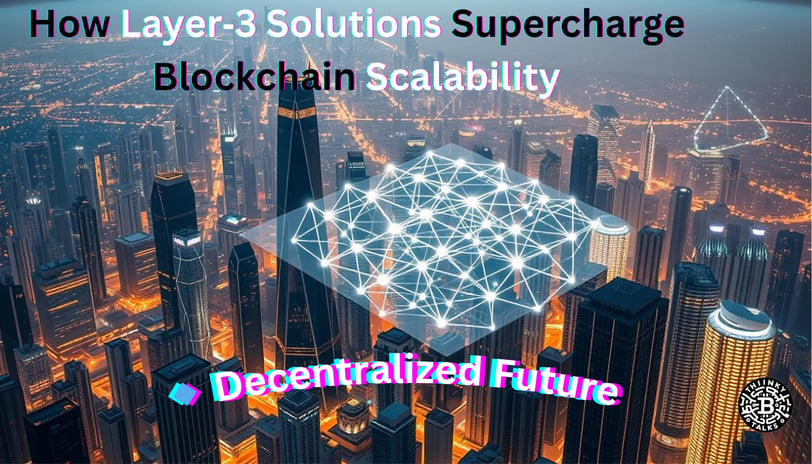

How Layer‑3 Solutions Supercharge Blockchain Scalability
Blockchain technology is changing many industries, but it faces a big challenge: scalability. A recent study revealed that over 80% of blockchain projects fail due to scalability issues. Layer-3 solutions are here to help, making blockchain much more scalable.
Key Takeaways
Layer-3 solutions significantly improve blockchain scalability.
They enable faster transaction processing times.
Layer-3 solutions enhance overall network reliability.
They are crucial for the success of blockchain projects.
Layer-3 solutions offer a promising solution to blockchain scalability challenges.
The Blockchain Scalability Trilemma
The scalability trilemma is at the core of blockchain's challenges. It shows the hard balance between scalability, security, and decentralization. This balance is key to understanding blockchain's scaling hurdles.
Understanding the Three Core Challenges
The blockchain scalability trilemma has three main parts: scalability, security, and decentralization. Scalability means a network can handle lots of transactions at once. Security keeps the network safe from hackers. Decentralization means the network is spread out, not controlled by one person.
Why Traditional Blockchains Struggle with Scale
Traditional blockchains face scaling issues because they focus on security and decentralization. This makes them slower than centralized systems. Layer3 blockchain scalability solutions aim to fix this by adding extra layers for better performance.
Evolution of Blockchain Layers: From Layer-1 to Layer-3
The journey to make blockchain more scalable has seen the growth of new layers. Each layer tackles specific challenges. This layered approach has greatly improved blockchain's scalability and use.
Layer-1: The Foundation Protocols
Layer-1 is the base of a blockchain network, like Bitcoin or Ethereum. It handles the core functions, like checking transactions and reaching an agreement. But, Layer-1 faces limits due to block size and how fast blocks are made.
Layer-2: The First Scaling Solutions
Layer-2 solutions were created to solve Layer-1's scalability problems. They include state channels, sidechains, and rollups. These technologies help process transactions more efficiently, boosting network speed. Layer-2 has greatly improved blockchain's scalability.
Layer-3: The Next Frontier of Scalability
Layer-3 is the next step in making blockchain more scalable. Layer3 scaling solutions in Web3 aim to offer scalable and customizable spaces for dApps. With layer3 blockchain, developers can build complex apps that run faster and cost less.
The move from Layer-1 to Layer-3 shows how fast blockchain scalability is advancing. As the field grows, we'll see even more groundbreaking solutions. These will make blockchain technology even more powerful.
What Exactly Are Layer-3 Blockchain Solutions?
Layer-3 blockchain solutions are changing how we see blockchain scalability. They aim to make blockchain networks better and more functional. They build on what Layer-1 and Layer-2 solutions have started.
Technical Definition and Architecture
Layer-3 blockchain solutions are special layers for certain tasks. They handle things like privacy, data, and complex calculations. They work on top of Layer-2, making things even better for specific needs.
The design of Layer-3 solutions is flexible. This lets developers create exactly what their apps need.
How Layer-3 Differs from Layer-1 and Layer-2
Layer-3 is different from Layer-1 and Layer-2. Layer-1 is the basic blockchain protocol. Layer-2 helps scale it a bit. But Layer-3 focuses on making apps work better.
Layer-3 solutions let us build more complex apps on blockchain. This makes the whole ecosystem stronger.
The Ecosystem of Layer-3 Technologies
The world of Layer-3 technologies is growing fast. New projects and protocols are coming up. They tackle things like privacy, data analysis, and smart contracts.
As it grows, we'll see even more cool uses of Layer-3 tech.
The Mechanics behind Layer-3 Blockchain Scalability
Understanding Layer-3 blockchain scalability is key for developers. It helps unlock blockchain's full potential. Layer-3 solutions improve scalability with new mechanics.
Computation Distribution Models
Advanced computation distribution models are central to Layer-3. They spread out tasks among nodes. This boosts efficiency and lightens the load on each node.
Data Availability Solutions
Layer-3 also uses advanced data solutions. These ensure that data is accessible and trustworthy. They keep blockchain apps running smoothly.
Cross-Layer Communication Protocols
Cross-layer protocols are vital. They make it easy for different blockchain layers to talk to each other. This includes:
Bridging Technologies
Bridging tech helps move assets and data between blockchains. It boosts interoperability and expands what's possible.
Message Passing Systems
Message systems ensure info is sent reliably and safely. They keep the blockchain running smoothly.
The table below shows how Layer-1, Layer-2, and Layer-3 differ in scalability:
Comparing Layer-3 Scaling Solutions in Web3
The search for scalability in Web3 has led to many Layer-3 solutions. Each has its own strengths. As the blockchain world grows, it's key to know the differences between these solutions.
Comprehensive Comparison Table of Major Solutions
A detailed look at major Layer-3 scaling solutions shows their unique features. The table below highlights these differences:
Performance Metrics Breakdown
When looking at Layer-3 solutions, key performance metrics are important. StarkNet and zkSync show high transaction throughputs, beating traditional Layer-1 blockchains.
Each solution has different performance metrics. Some have better latency, while others have higher throughput. Knowing these metrics helps choose the right solution for your needs.
Cost-Efficiency Analysis
Cost-efficiency is a big factor when comparing Layer-3 solutions. zkSync offers high scalability but might be more expensive. Polygon balances scalability with cost.
Looking at cost-efficiency means considering transaction fees and operational costs. These costs are important for deploying and keeping these solutions on the blockchain.
Step-by-Step: How to Implement Layer-3 Solutions
To boost your blockchain project, follow this guide on Layer-3 implementation. Layer-3 solutions are key to making blockchain faster and more efficient.
Step 1: Assessing Your Project's Scalability Requirements
First, check what's slowing down your project. Look for bottlenecks where Layer-3 can help a lot. Think about how many transactions you can handle, how fast, and how well your network works.
Step 2: Selecting the Appropriate Layer-3 Technology
There are many Layer-3 options. Pick the one that fits your project best. Look at what each offers in terms of speed, safety, and working with other systems.
Layer-3 Technology
Step 3: Integration and Deployment Strategies
After picking a Layer-3 tech, make a detailed plan for integration. This means setting up the needed infrastructure, making sure different layers talk to each other, and keeping data flowing smoothly.
Development Workflow
Create a solid development process. This should include regular testing, continuous improvement, and keeping track of changes. This way, your Layer-3 solution is well-tested before it goes live.
Testing Methodologies
Use strict testing methods to check your Layer-3 solution's performance and safety. This includes stress tests, security checks, and measuring how well it works.
Layer-3 scaling solutions in Web3
By following these steps, you can successfully add Layer-3 solutions to your blockchain project. This will greatly improve its speed and performance.
Case Study: Ethereum's Layer-3 Ecosystem
Ethereum is tackling its scalability issues with Layer-3. This ecosystem shows Ethereum's ability to grow and stay ahead in decentralized apps. We'll look at how Layer-3 solutions like StarkNet and zkSync's Hyperchains are making a difference.
Stark Net’s Layer-3 Implementation
StarkNet leads in Ethereum's Layer-3 development. It uses zero-knowledge rollups to boost transaction speed and keep Ethereum secure. The benefits are clear:
More scalability with off-chain computation
Lower gas fees for users
Stronger security with cryptographic proofs
ZkSync’s Hyperchains
ZkSync’s Hyperchains are another key Layer-3 solution for Ethereum. They create interconnected Layer-2 and Layer-3 networks. This makes interactions smoother and scales the ecosystem. The benefits include:
Better interoperability between chains
More scalability with a modular design
Faster transaction processing
Measured Performance Improvements
Layer-3 solutions have greatly improved Ethereum's performance. Key metrics show:
Transaction Throughput Data
Layer-3 solutions like StarkNet have boosted Ethereum's transaction speed by up to 500%. This is a big step towards wider adoption.
Fee Reduction Statistics
Transaction fees have also dropped significantly. For example, zkSync's Hyperchains have cut fees by 70% on average. This makes Ethereum more user-friendly.
Case Study: DeFi Applications Leveraging Layer-3 Technology
Layer-3 scaling solutions are being used in DeFi apps to boost performance. This is key as DeFi grows, needing scalable and efficient blockchain tech.
Decentralized Exchanges on Layer-3
Decentralized exchanges (DEXs) greatly benefit from Layer-3 tech. They can now handle more transactions, cutting down on costs and improving user experience. For example, DEXs using Layer-3 have seen lower transaction fees and faster speeds.
Lending Protocols and Their Scalability Solutions
Lending protocols also see big benefits from Layer-3 tech. They need to process lots of transactions quickly and efficiently. Layer-3 solutions help these protocols grow, ensuring they meet demand without losing performance.
Real User Experience Improvements
Layer-3 tech has made DeFi apps better for users. People now enjoy quicker transactions, lower fees, and smoother interactions. This is key for DeFi's growth, solving major blockchain issues.
Key benefits of Layer-3 technology in DeFi include:
Increased scalability
Improved transaction speeds
Reduced transaction costs
Enhanced user experience
As DeFi keeps growing, Layer-3 solutions will be more vital. They offer the needed scalability and efficiency, setting the stage for DeFi's future.
Key Benefits of Layer-3 Scaling Solutions for Developers
Developers are now using Layer-3 scaling solutions to solve old blockchain problems. Layer-3 tech gives a strong base to tackle the scalability trilemma. This lets developers make apps that are better, faster, and easier to use.
Simplified Application Development
Layer-3 solutions make app development easier. They create a smoother, more efficient space for developers. This means they can work on new features without getting bogged down by tech issues. It speeds up development and cuts costs.
Enhanced Customization Options
Layer-3 offers more ways to customize apps. This is key in a fast-changing market where being flexible is crucial. With Layer-3, developers can change and add to their apps freely, without being held back by the base protocol.
Future-Proofing Your Blockchain Project
Using Layer-3 tech helps developers make blockchain projects that last. Layer-3 solutions are made to grow and adapt, keeping up with user needs and tech advances. This forward-thinking way helps developers stay competitive.
Layer-3 blockchain scalability
In summary, Layer-3 scaling solutions give developers the means to build better, more flexible, and lasting blockchain apps. They simplify development, boost customization, and ensure projects stay relevant. Layer-3 tech is changing the game for blockchain development.
Overcoming Challenges in Layer-3 Implementation
The journey to add Layer-3 solutions is filled with technical, security, and adoption obstacles. Developers must grasp the details of Layer-3 blockchain technology to overcome these hurdles.
Technical Hurdles and Solutions
Ensuring smooth interaction between different blockchain layers is a major technical challenge. To solve this, developers can use cross-layer communication protocols. These protocols help in easy data transfer and transaction processing.
Scalability is another big challenge. Layer-3 solutions aim to improve scalability but must keep the network secure and decentralized. Using computational distribution models can help strike a balance.
Security Considerations and Best Practices
Security is essential when adding Layer-3 solutions. Developers need to make sure these additions don't create new risks. They should conduct detailed security audits and use robust encryption methods.
Adoption Strategies for New Projects
New projects should first assess their scalability needs when considering Layer-3 solutions. They should understand their current and future needs. Then, choose a Layer-3 technology that fits these needs.
By tackling these challenges, developers can successfully integrate Layer-3 solutions. This enhances the scalability and efficiency of their blockchain projects.
The Future Roadmap of Layer-3 Blockchain Development
Layer-3 blockchain is on the verge of a new era. It promises better scalability and efficiency. As the blockchain world grows, we must look at new trends and innovations. These will shape the future of Layer-3 solutions.
Emerging Trends and Innovations
The next Layer-3 blockchain solutions will focus on working together across different networks. This will make the ecosystem more connected and cohesive.
Another big trend is combining Layer-3 with Artificial Intelligence (AI) and Machine Learning (ML). This will make blockchain apps more efficient and predictive.
Potential Industry Disruptions
Layer-3 solutions will change many industries with their scalable and efficient blockchain. The financial sector will see faster and safer transactions.
Research and Development Frontiers
Future research will aim to improve data availability and cross-layer communication. Innovations in zero-knowledge proofs and cryptography will also be key.
Trend
Impact
Interoperability
Enhanced cross-chain functionality
AI/ML Integration
Improved predictive capabilities
Data Availability
Better scalability and efficiency
As Layer-3 blockchain development moves forward, we'll see big improvements. Scalability, efficiency, and blockchain adoption will all get better.
Conclusion: Embracing the Layer-3 Revolution
Layer-3 blockchain solutions are a big step forward in blockchain tech. They build on what Layer-1 and Layer-2 have started. This means faster transactions and a better user experience.
Layer3 solutions are changing how we use blockchain. They make it more scalable and efficient. This opens up new possibilities in many industries. As blockchain grows, so will the need for Layer-3 solutions.
Looking ahead, layer3 scalability has the power to change blockchain. By embracing this change, we can unlock blockchain's full potential. This will drive innovation and growth in the future.
FAQ
What are Layer-3 blockchain solutions, and how do they enhance scalability?
Layer-3 blockchain solutions are built on top of Layer-1 and Layer-2 protocols. They add more scalability and functionality. They do this by spreading out computation, making data more available, and improving communication between layers.
How do Layer-3 solutions differ from Layer-1 and Layer-2 solutions?
Layer-3 solutions are different from Layer-1 and Layer-2 in their design and function. Layer-1 is the base protocol, and Layer-2 offers the first scaling solutions. Layer-3, on the other hand, focuses on scaling and adding features for complex applications.
What are some examples of Layer-3 blockchain solutions?
StarkNet and zkSync's Hyperchains are examples of Layer-3 blockchain solutions. They show how Layer-3 can greatly improve scalability and performance in blockchain applications.
How do Layer-3 solutions improve the user experience in DeFi applications?
Layer-3 solutions make DeFi applications better by speeding up transactions and lowering fees. They also make it easier to use decentralized exchanges and lending protocols. This leads to a smoother and more efficient user experience.
What are the key benefits of Layer-3 scaling solutions for developers?
Developers gain a lot from Layer-3 solutions. They make app development easier, offer more customization, and help future-proof projects. These benefits help developers build more complex and scalable apps.
What challenges might developers face when implementing Layer-3 solutions, and how can they be addressed?
Developers might run into technical, security, and adoption issues with Layer-3 solutions. These can be overcome by following best practices, testing thoroughly, and keeping up with the latest Layer-3 tech.
What is the future roadmap of Layer-3 blockchain development?
The future of Layer-3 blockchain development will be shaped by new trends, innovations, and ongoing research. As Layer-3 evolves, we can expect big improvements in scalability, security, and usability.
Ready to scale beyond limits?
Dive deeper into the Layer-3 revolution and future-proof your blockchain project today.
👉 Start building smarter — embrace Layer-3 now.
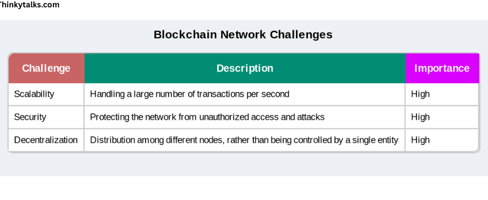

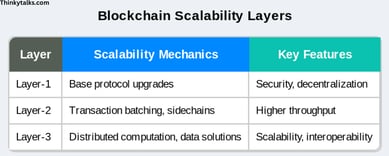

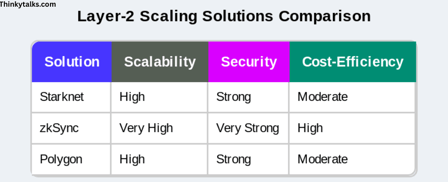

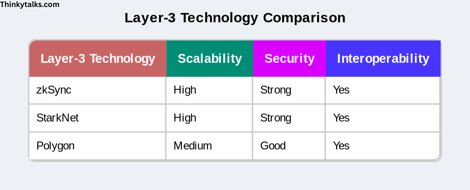





Thinky Talks
Stay updated on crypto, blockchain, and innovation.
© 2025. All rights reserved.
